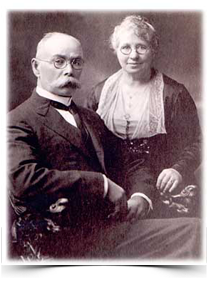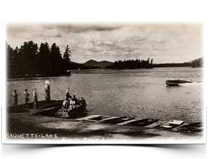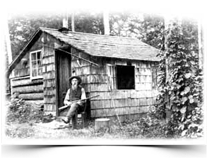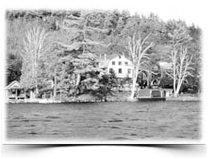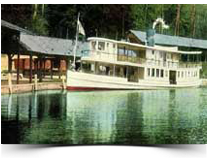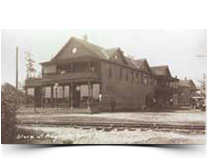Built in the Adirondack backwoods in the century before last, The Brightside was home for the Bryere family (pronounced Brier or Bree-air), as well as for a host of the famous and infamous. Joe and Mary Bryere struggled during those early years, experiencing hard living amid the beauty of the woods and animals. In those days, one could stand on the shores of Raquette Lake and see few other people. Perhaps only a beaver, a moose or maybe a jumping fish were there to greet Joseph O.A. Bryere when he migrated from St. Anne de la Parade, Quebec in 1880.
In 1884 Joe married Mary Agnes Gooley at Ed Bennett's Inn, "Under the Hemlocks," which was located at Long Point on the lake. In the year that it took the couple to build The Brightside, Joe and Mary lived in a tent, later in a shack, and eventually moved into the original hotel in front of the "Crags," a rocky hill that was considered great for climbing. One by one they added cabins, a boathouse, and a water tower. Eventually they created a vacation complex of more than 100 acres. Some visitors would stay for a week or two, and others for the entire summer.
The Brightside advertised all the modern conveniences, plus water sports, tennis courts, hiking, and golf which was available at a nearby golf course. When it opened in May of 1891, some world travelers exclaimed that Brightside on Raquette was a paradise. Today, many people consider it that same turn-of-the-century gem.
A Strong and Resourceful Family
Together, Joe and Mary constructed buildings in the style of the great camps of their day. In terms of stamina, Joe and Mary were a good match. Mary could swing an ax and pull a crosscut saw on a par with any man, and legend has it that Joe killed a 1,200-pound bull moose with his bare hands in his younger days in Canada.
With the help of his friend and sometimes boarder Seth Pierce, Joe constructed a carpenter shop over the boathouse where he built wonderful Adirondack-style furniture. Today, many of these pieces are on display at the Adirondack Museum. Joe was a genuine artist of rustic work, according to a Seneca Ray Stoddard guidebook. One of those pieces is a grandfather clock, which he built out of the piano case from the piano he bought in 1887; the piano is still in the main hotel building at The Brightside. The clock now stands tall in the Adirondack Museum at Blue Mountain Lake.
Joe was involved in local affairs, and shouldered many responsibilities over the years. In those days before the Frigidair, people had to take ice from the lake and store it in the icehouse. The "hole" in the ice was a long strip that needed to be kept open in winter by pushing a block of ice back and forth throughout the cold night. When Joe was responsible for keeping the strip open, he kept a bottle of whiskey at each end for warmth and protection against the bitter cold. Joe also served for some years as the town coroner.
The Bryere's had four children, starting with Franklyn in 1894 and continuing with Florence, Clara, and Kathleen or "Babe." In winter, all of the children snowshoed across the lake to a school at the J. Pierpont Morgan estate on Long Point. In spring and fall, they traveled to school via guide boat. They must have been good students because their teachers, Arthur Martin and Dennis Dillon, both lived at The Brightside.
Colorful Visitors
Many intriguing people helped make Brightside the unique resort that it was.
Messrs. Martin and Dillon, along with some other interesting characters, delivered presents to the Bryere children at Christmas. One of the men, old Seth Pierce, was a guide, carpenter, and Civil War veteran. At Christmas, Seth would get dressed in his old Civil War uniform and was quite a sight with his long white beard. On quiet mornings, they would gather all the children and raise the flag out on the dock for all to see.
Beyond old Seth Pierce, there were other Adirondack Guides like Pete Tromblee, an Indian. He would answer an owl's call with "This is me, Pete Tromblee, who in the hell are you?" to everyone's laughter. Then there was Warren Steves, who had been a guide for men like Cornelius Vanderbuilt and President Ulysses S. Grant. The guide Duane Fuller also visited here. He is famous for shooting a panther in the dark of night by aiming at nothing more than the gleam in its eyes.
Beecher LaPrarie, a fellow son of Quebec, delivered the mail year-round. In winter, he made his rounds on snowshoes. In summer, he walked from his home at Blue Mountain Lake. Other guides who visited Brightside were C. H. Hendy and Henry Callahan from Forked Lake, and Melvin Burnham, Henry Taylor, Amos and Charlie Blanchard from Blue Mountain Lake. The locals who often visited Brightside were Frank Wood, Calvin Town, Willard Sutton and Charlie Blanchard, all of Raquette Lake.
The most colorful character of all was old Alvah Dunning who for many years lived on Ospry Island. There he fought off, sometimes with shotgun in hand, the claims that New York State owned the island. He later sold the island to Charles Durant, a cousin of William West Durant. Dunning was one of the six most famous Adirondack guides, having guided for such men as Rev. William H.H. "Adirondack" Murray and President Grover Cleveland.
Dunning, a Democrat, was once asked why he always used Royal Baking Powder when he should be using Cleveland Baking Powder in support of the President. He had no good answer so he switched.
Letter to President Cleveland
During the time that Grover Cleveland was President, he received a letter from Dunning that stated, "Some time ago Ike Kenwell asked me to catch you some lake trout. I done so. He offered to pay me but I did not take any pay. Just now I am out of Baking Powder and if you would send me some I would be much obliged to you. A. Dunning." President Cleveland, who had nothing to do with the baking powder company, sent two cases of Cleveland Baking Powder to Dunning.
Dunning later moved away from Raquette Lake because he said it was getting too civilized. He died in a Utica hotel after blowing out the flame in a gas jet just as he had done with the kerosene light at home. The gas light should have been turned off to stop the flow of the gas. He, like so many others of the "gaslight" era, died of asphyxiation in March of 1902.
The Second Generation
Eventually, all of the children moved away. Kathleen, now Kathleen Grant, returned each summer with her family to help run the resort. Clara became a nurse in World War I with General Pershing's headquarters company in France. She returned home after her father's death in 1941 to run the Brightside.
Joe Bryere had operated The Brightside for 50 years. In his later years, he lost one leg to frostbite and had to be carted around the property in a wheelbarrow. When Clara took over in 1941, after her father's death, she inquired of her mother how much wood to bring in or how many provisions to buy, only to be told, "Father did that, I don't know."
Despite the formidable challenges, Clara was able to run The Brightside and even made some improvements. She added a pump so that water could be drawn from the lake without keeping a hole open all winter as had been done in her father's day. Clara became known as "Miss Brightside" and ran the old inn until 1957 when she, reserving life use of Pine Cottage, sold The Brightside to a newly formed corporation, Brightside on Raquette Lake Incorporated. The corporation ran The Brightside until the mid sixties. Actually, the corporation did more family business than money-making business, selling lots to friends of The Brightside. Clara Bryere donated much of her father's rustic furniture to the Adirondack Museum when it opened in 1957.
Preserving the Brightside
When purchased in February 2001 by the The Light Connection and its president, Frank Giotto, The Brightside was in need of much repair and updating. "Modern" conveniences of the 1910 era were very different from what we enjoy today. Lacking indoor plumbing, every room had a bowl and pitcher for washing, and a chamber pot served as the toilet. So plumbing and bathroom facilities had to be installed on every floor. The large coal-burning furnace, which sat in the center of the cellar, was replaced with three propane furnaces. The long-neglected windows with broken panes were replaced, and the building's foundation was repaired. Both new and antique furniture has been purchased to make a visitor's stay as comfortable and enjoyable today as it was in years gone by.
Outside, new porches were built on the east and south sides of the Inn. The old wood shed that housed an ancient generator with big glass storage batteries is now gone. Paint has done wonders to make the outside of the Brightside look warm and inviting, and a new roof, which looks much like the original, is the crowning achievement.
